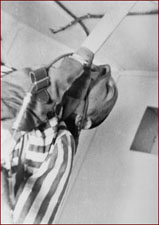
|

|
|
 A prisoner during low-pressure experimentation at
Dachau, 1942.
A prisoner during low-pressure experimentation at
Dachau, 1942.
|
What if you knew just how much victims of the experiments
suffered?
"One cannot fully confront the dilemma of using the results of
Nazi experiments," the attorney and ethicist Baruch Cohen has
written, "without sensitizing one's self to the images of the
frozen, the injected, the inseminated, and the sterilized."
[26] One could add without sensitizing oneself to eyewitness
testimony. Obviously, the hundreds who died at the hands of
Nazi death-camp doctors cannot tell their story of
unfathomable fear, unbearable pain, and senseless death. One
must rely on those who survived and those who witnessed the
execrable atrocities that occurred in the concentration camps.
Here is some of that testimony:
"The third experiment ... took such an extraordinary course
that I called an SS physician of the camp as witness, since
I had worked on these experiments all by myself. It was a
continuous experiment without oxygen at a [simulated] height
of 12 kilometers [39,283 feet] conducted on a 37-year-old
Jew in good general condition. Breathing continued up to 30
minutes. After four minutes the experimental subject began
to perspire and wiggle his head, after five minutes cramps
occurred, between six and ten minutes breathing increased in
speed and the experimental subject became unconscious; from
11 to 30 minutes breathing slowed down to three breaths per
minute, finally stopping altogether."
—From a report by Dr. Sigmund Rascher to Heinrich
Himmler dated April 5, 1942 concerning his
high-altitude experiments
on prisoners at Dachau concentration camp [27]
"Fifteen girls aged 17 to 18 years old. The girls who
survived the following operations are in German hands and
little is known about them. The subjects were placed in an
ultra-short-wave field. One electrode was placed on the
abdomen and another on the vulva. The rays were focused on
the ovaries. The ovaries were consequently burned up.
Owing to faulty doses several had serious burns of the
abdomen and vulva. One died as a result of these burns
alone. The others were sent to another concentration camp
where some were put in hospital and others made to work.
After a month they returned to Auschwitz where control
operations were performed. Sagittal and transverse sections
of the ovaries were made.
The girls altered entirely owing to hormonal changes. They
looked just like old women. Often they were laid up for
months owing to the wounds of the operations becoming
septic. Several died as a result of sepsis."
—Sterilization experiment
at Auschwitz, as described by two Dutch doctors who had
been prisoners there [28]
"It was the worst experiment ever made. Two Russian officers
were brought from the prison barracks. Rascher had them
stripped and they had to go into the vat naked. Hour after
hour went by, and whereas usually unconsciousness from the
cold set in after 60 minutes at the latest, the two men in
this case still responded fully after two and a half hours.
All appeals to Rascher to put them to sleep by injection
were fruitless. After the third hour one of the Russians
said to the other, 'Comrade, please tell the officer to
shoot us.' The other replied that he expected no mercy from
this Fascist dog. The two shook hands with a 'Farewell,
Comrade' ... These words were translated to Rascher by a
young Pole, though in a somewhat different form. Rascher
went to his office. The young Pole at once tried to
chloroform the two victims, but Rascher came back at once,
threatening us with his gun ... The test lasted at least
five hours before death supervened."
—Testimony given at the "Doctors Trial" at
Nuremberg by Walter Neff, an Auschwitz prisoner who
served as Dr. Sigmund Rascher's medical orderly during
hypothermia experiments
[29]

Yes
|
No
References
26.
Cohen, p. 2.
27. Katz, Jay. "Abuse of Human Beings
for the Sake of Science." In
Caplan, p. 233.
28.
Gilbert, p. 374.
29. Shirer, William L.
The Rise and Fall of the Third Reich: A History of Nazi
Germany. New York: Simon & Schuster, 1960, p. 987.
Photo: National Archives, Courtesy of USHMM Photo
Archives
The Director's Story
|
Timeline of Nazi Abuses
Results of Death-Camp Experiments: Should They Be Used?
Exposing Flawed Science
|
Resources
Transcript
|
Site Map
|
Holocaust on Trial Home
Editor's Picks
|
Previous Sites
|
Join Us/E-mail
|
TV/Web Schedule
About NOVA |
Teachers |
Site Map |
Shop |
Jobs |
Search |
To print
PBS Online |
NOVA Online |
WGBH
©
| Updated October 2000
|
|
|



